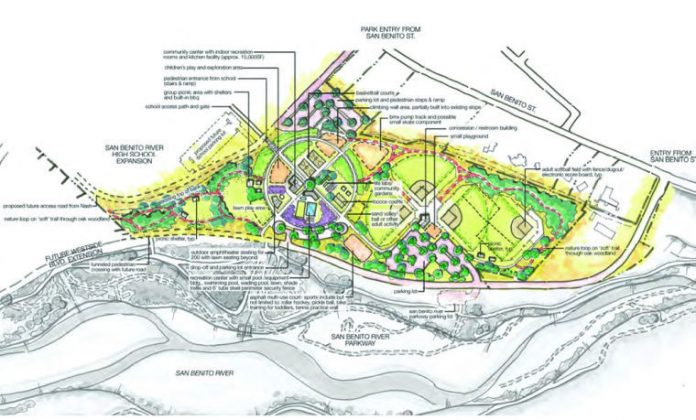San Benito County’s new 20-mile long River Parkway Master Plan has just about everything. The central focus area and Regional Park adjacent to Hollister has a community center, outdoor amphitheater, swimming pool, softball fields, basketball courts, a playground, educational gardens, an orchard, shade trees and a picnic area – among other things such as walking, biking and equestrian trails. Its biggest problem is that is has a price tag to match.
The central Regional Park alone has a 2012 estimated construction cost of between $37 million and $41 million. The total 20-mile long project may cost two or three times that, $80 million to $120 million, and substantial user fees would certainly be required merely for upkeep. If money were no object, this plan would be perfect. Unfortunately, money is a very large object for this county and its residents. Planners and supporters have emphasized that this was what the community wanted, but part of any successful plan is not just a vision – it has to include execution. In this case, the cost may be the project’s poison pill.
There are only limited funding possibilities for parks and recreation land acquisition and construction. One is public or private grants – having a master plan is an advantage provided the grants are large enough to fund a significant piece of the pie. However, as the price goes up, this becomes more difficult. The other funding sources are direct and indirect taxpayer contributions through special bonds and/or increased impact fees, both of which can adversely affect development and the disposable income necessary to fuel the local economy.
Without limits imagination can run free, but what the public purse is willing to support is usually nowhere near as flexible. Local public projects must be right-sized and return early benefits to gain public acceptance. We do not have to settle for bare bones, but the resources must be within reasonable reach, with a little stretch.
The mangers suggested that one can reach into the master plan and pull out a selection for a limited project, but that is a lot harder than it appears practically, psychologically, and politically. If we go for a major piece that satisfies many voters with a plethora of offerings, the $40 million price tag for the central area alone and realistic user fees will likely sour many of them. If we try to reduce the cost by severely limiting the offerings, many residents will be wondering, “Where are the things I wanted?” Will they be willing to pay for someone else’s favorite pastime now and wait a decade or two for theirs? That’s the hazard of overpromising.
In hindsight, I believe that the master plan should have done more to prioritize the offerings and limit the public’s choices to those items that can reasonably be accomplished, because the first requirement will be to obtain funding support and the second will be have a success story. It will be much easier to build onto a successful small project piece by piece rather than ask for funding of a grand idea that is so far beyond our means.
The work put in so far is certainly not wasted, but it is now critical that the planners go back, prioritize the offerings, and bundle the most popular and most achievable into much smaller packets that have a better chance of gaining acceptance at the polls without stifling future development. Bigger and grander is not always better and failed expectations are bitter pills to swallow. Let’s start with a small and affordable success.
Marty Richman is a Hollister resident.










